According to Dr Abie Khan, quality and food safety manager at Willowton Group, the company's third river clean-up at the Baynespruit River on 15 February, just ahead of the 2022 Dusi Canoe Marathon, revealed that reducing the rubbish in the river itself actually brought down levels of E. coli which are an ongoing health hazard.

Source: Supplied
This entails removing both refuse such as plastic, paper and cardboard, metal and alien vegetation as well as improving the water quality.
Samples show drop in E. coli levels
The Willowton Group had partnered with Pietermaritzburg-based Talbot Laboratories, a Sanas accredited testing facility, to assess the quality of the water in the Baynespruit. The water samples taken before and after the clean-up revealed that the very high levels of E. coli prior to the removal of waste dropped significantly afterwards but then began to rise again.
Micole Martens, general manager of Talbot Laboratories, said that samples taken prior to 15 February were high (648,800) but dropped to below 100,000 (98,040) six hours after clean-up. Unfortunately, Martens added, they started increasing the next day.
This demonstrated that a physical clean-up allowed for better flow and “cleaned” the river. The counts started increasing once more because the pollution from upstream continued. Things like crisp packets, plastic bottles and even trolleys often make their way into rivers.
Dr Khan said that this latest clean up by Willowton Group yielded over some 300m of the 1km stretch 2.217 tons of plastic, metals for recycling and vegetation. The group says it's currently exploring the process of composting the vegetation removed from the Baynespruit for use in the Willowton garden.
Removing pollutants enables access to clean water
Martens stressed that both physical pollutants and bacterial and chemical pollutants that were not visible needed to be removed from the Baynespruit to make it safe for local communities without access to clean water via the municipality to use it.
“Rivers contain microbial life and pollutants from a range of natural sources. For example, livestock animals are kept in the vicinity of a river. They can defecate directly into the waterway. Even without direct access, rainwater can mix with manure and other animal waste before draining into the river as runoff.
Teresa Sandra Perez 4 Feb 2022 Martens added that during periods of heavy rain such as that experienced in the KwaZulu-Natal Midlands, storm water from treatment works and storm drains from the sewer network resulted in rainwater mixed with raw sewage being discharged into rivers.
“This means that the majority of what gets flushed down the toilet or poured down the sink – including non-biodegradable items like wet wipes – ends up polluting the river. In theory, the rainwater should dilute the raw sewage and screens should remove gross solids, however, the existing infrastructure can’t cope with our rapidly increasing population, leading to many discharging more often than they should,” she explained.














































